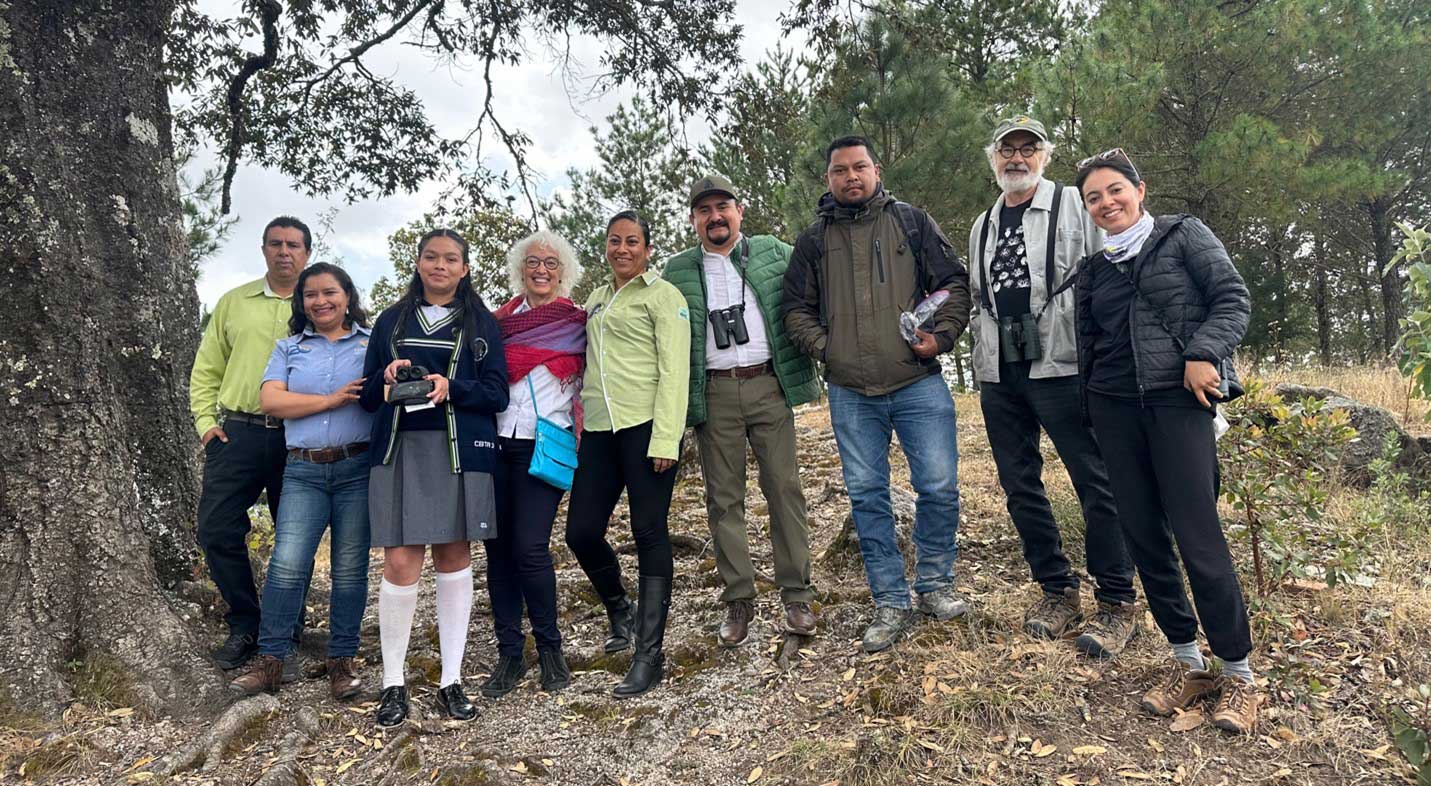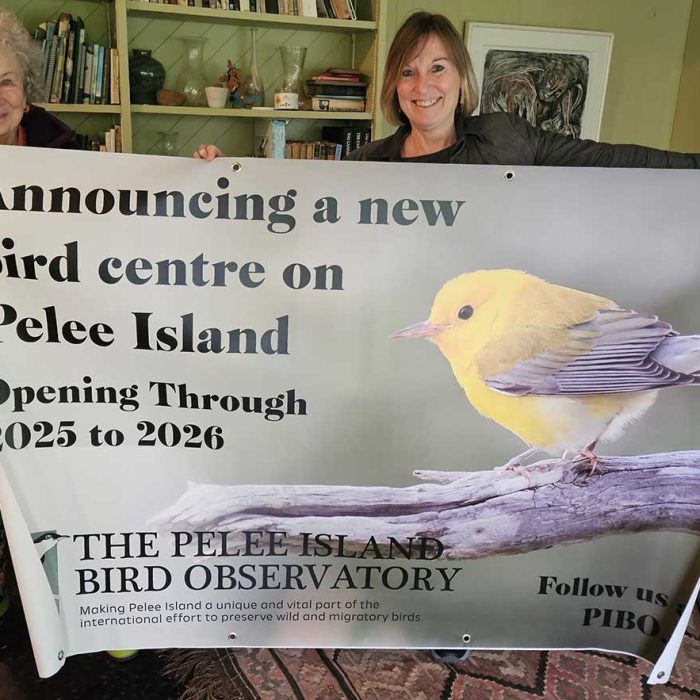Birds Are Bridges
The Graeme Gibson Prismaticos Project 2023
By Wayne Grady, Merilyn Simonds, and Rodrigo Lopez
Four people, two men and two women, stand at the end of a long corridor, looking through raised binoculars at something at the far end of the building. Their instructor, also with binoculars, tells them to cover their left lens with one hand and to turn the right eyepiece with the other, until the sign at the end of the corridor comes into focus. There follows much dexterous contortion and a lot of laughter. Then the instructor says to cover their right lenses and bring the left lens into focus using the focusing ring between the two lenses. The four volunteers exclaim, “Ah,” and “Si, si, puerdo verlo!” And one by one they read the sign aloud: “Palacio Municipal, Acámbaro. Oficina del Presidente del Municipal.”
“Bueno,” says the instructor, turning to us and translating: “Acámbaro City Hall, Office of the Mayor. Very good!”
Rodrigo Lopez has just shown the first recipients of the first pairs of binoculars from PIBO’s Prismaticos Project how to adapt their new binoculars to their own eyes. The laughter and smiles deepen, there are handshakes and Muchas gracias all around, and we gather at the top of a set of stairs for official photographs. The event is being meticulously recorded on five smart phones. Rodrigo has given a brief explanation of the purpose of the Project, and now it’s time for the four happy volunteers to try out their new equipment in the field. For them, although they have been conducting bird surveys and guiding nature tours in the local conservation area for years, it will be the first time they have actually seen a bird through a pair of binoculars. They are prepared to be amazed.
The Graeme Gibson Prismaticos Project was conceived in 2022 as a PIBO outreach initiative, with the goal of collecting donated binoculars and spotting scopes in Canada and distributing them to schools, environmental groups and park rangers in the state of Guanajuato, in Central Mexico, where the cause of environmental protection to endangered species and habitat is hampered not by lack of enthusiasm, but by a lack of equipment. Flyers were distributed at PIBO events in the spring and summer of 2022, donations were received, and in November we shipped 24 pairs of binoculars to Rodrigo, in San Miguel de Allende. Rodrigo in turn solicited applications from environmental groups and guardabosques (forest rangers) in Guanajuato.
Of the 24 pairs we sent, four were deemed to be in irreparable condition; nine were in need of minor repairs; and eleven were in excellent condition. Rodrigo sent the reparable binoculars to Mexico City to be reconditioned, and together we whittled the thick stack of applications down to a preliminary nine.
The recipients were divided between two major protected reservas naturales in the Mexican state of Guanajuato: the Sierra de los Agustinos, a protected ecological area near Acámbaro, and the Sierra Gorda Biosphere Reserve of Guanajuato, a larger protected area in the eastern part of the state where it borders on the Sierra Gorda Biosphere Reserve of Querétaro. Although both biospheres are officially “protected” from development, the federal government provides meagre funding for conservation or even surveying the protected areas. It isn’t clear what’s in them. And the state governments are too underfunded to do much more than establish local offices staffed by a paid director and, sometimes, one assistant. These rely on unpaid and under-equipped volunteers from local communities to carry out the basic monitoring and restoration work that will keep the “protected” areas protected.
On February 3, 2023, Merilyn, Wayne and Rodrigo drove to Acámbaro to deliver the first four pairs of binoculars. The four recipients work in the Sierra de los Agustinos, under the auspices of the Acámbaro Conservation and Ecology Department, whose director is Alejandro Morales, His assistant, Eliot Comacho, coordinates the volunteer program that is receiving the binoculars. The volunteers are happy and excited; they have been working for years without the proper equipment to carry out the work they know is important to their region.
The Sierra de los Agustinos, a 200-square-kilometre natural ecosystem, was declared a protected area in 2002, largely because it sits atop the vast Acámbaro Aquifer that provides drinking water to the city (population 100,000) and irrigation to much of the agricultural region. When we approached the city, Rodrigo pointed out the range of low mountains in the distance that constitute the biosphere. It seemed to us historically appropriate the reserva is named for monks of the Augustinian Order, since that was the first religious group to be sent by Spain to the New World. As a teaching order, the Agustinos arrived in 1533 and a few years later established the first university in the New World, near the Michoacan capital of Morelia and not all that far from Acámbaro. Today, teachers from several nearby universities have been urging the state government to conduct bio-surveys and habitat restoration, and to limit visitors to the areas to supervised ecotourism groups, but so far little has been done except to designate these areas as excempt from logging, mining and urban development.
The Sierra de los Agustinos is home to 531 species of flora and 193 species of fauna, of which 145 species are birds. Local birds of interest include the Swainson’s hawk, the endemic Aztec thrush and the Olive warbler, and the quasi-endemic Brown-backed solitaire and Buff-collared nightjar. Two endangered species — the Aztec rail and the Black-polled yellowthroat — are found on the shores of nearby Lake Cuitzeo, which also falls under Acámbaro’s purview. The week before our visit, Alejandro, Eliot and their volunteers conducted a waterfowl survey of the lake, logging 57 species in a single day.
The Sierra de los Agustinos is also a major stopping-off point for migrating Monarch butterflies: it is their final resting place before they reach their wintering grounds in the mountains of the neighbouring state of Michoacan.
As we sit chatting with Alejandro and Eliot on a concourse overlooking the courtyard, the four volunteers who are to receive the binoculars arrive, all smiles, and are introduced: by Alejandro. Armida Robles is a freelance graphic designer; Abraham Negra works for a fertilizer and seed distributor; Patricia Diaz is a kindergarten teacher; and Gustavo Gonzales works at the Acámbaro campus of the University of Central Mexico, in the Department of Environmental Studies. As volunteer guardabosques, their responsibilities in the Sierra de los Agustinos include planting trees, cleaning up forest litter, and guiding tourists, school groups and nature walks within the park. They regularly monitor the park in order to ensure that visitors are there with permission and that the rules of access ae strictly followed. The biggest part of their work, however, is with bird surveys and guiding, and for these binoculars are essential tools.
Their enthusiasm is evident throughout our meeting. After the last municipal elections, when Alejandro’s and Eliot’s positions were temporarily suspended, they continued to work, without pay, until the situation was regulated. Today there is a distinct buzz of excitement as Rodrigo hands out the binoculars and Merilyn adds Peterson’s Guide to the Birds of Eastern and Central North America. It’s one thing to be able to see the birds, Alejandro says, but it’s also crucial to be able to identify them. He says he will keep the field guide in his office to be used during species surveys and bird counts. We say we will try to get more copies to him and other ecologia offices throughout the state.
“Our commitment has always been there,” says Abraham, holding his Nikon Venturer II binoculars (donated by the staff of the Upper Thames River Conservation Authority), “but with the proper equipment we can do a better job, and our commitment will become stronger.”
We leave Acámbaro amid handshakes, laughter and a chorus of Hasta luego, with the request that we return soon so they can take us birding in the Sierra de los Agustinos. As we drive back to San Miguel, we find ourselves thinking of a passage from a Donna Leon novel, in which Inspector Brunetti reflects that “Saint Augustine was wrong: it was not necessary for grace to be arrived at by prayer; it was as natural and abundant as sunlight.”
“There is a pair of Golden eagles nesting on that mesa,” Maru Mendiola says from the back of the van. We’re passing through a high, dry landscape in the Sierra Gorda, on our way to deliver the second lot of binoculars. Maru points to a flat, rocky hilltop called La Mesita del Tigre.”
“The Tiger’s Little Table,” Rodrigo jokes. “In Ontario,” he says, “Golden eagles may not be all that exciting, but down here, they’re like the Holy Grail.”
“They’re not all that common in Ontario, either,” I say. Golden eagles have only been seen six times on Pelee Island, and always in migration.
“We know of five mating pairs in the Sierra Gorda,” says Maru. “They are very closely monitored. Last year we found they had raised nine chicks.”
We’ve been driving through the Sierra Gorda Biosphere Reserve for an hour, restricting our birding to what we can spot from the van. So far, we’ve seen four Crested caracaras, three Acorn woodpeckers, two Phainopeplas, a Say’s phoebe, and a Vermilion flycatcher, as well as hordes of Cattle egrets and White-winged doves. Rodrigo thought he spotted a Woodhouse’s scrub jay on a fence post as we sped past, but upon reflection decided it was a Northern mockingbird. Besides the mockingbird and the Golden eagles, we’ll see other species shared by both the Sierra Gorda and Pelee Island on this trip: a Ruby-crowned kinglet, four Red-tailed hawks, numerous House finches, a Northern flicker, and an Eastern bluebird.
The Guanajuato portion of the Reserva de las Biosfera Sierra Gorda is huge – more than 2,500 square kilometres, and is still only half of the total Sierra Gorda Reserve (the other half is in the state of Queretero). It is also largely unknown, although a few dedicated naturalists are making inroads in surveying and recording the incredible diversity of species found in it. The Guanajuato website, for example, notes that the Reserve is home to 42 species of mammals, including the cacomixtle, the tlalcoyote, and the Spotted skunk. This seems low, given that the Sierra de los Agustinos harbours 195 species and is a tenth the size. The Guanajuato site adds that the Reserve has three species of snakes and the Kangaroo rat, but doesn’t mention birds at all! Even though the ministry has announced that it is keen to promote ecotourism, it’s clear that it has yet to appreciate the true extent of its own biodiversity. Which is why we’re here, delivering binoculars to those dedicated field workers who so far have been toiling with little support and almost no basic equipment.
Another hour of driving deeper into the Reserve and we arrive at San Miguel de las Casitas, a remote community in the equally remote municipality of Xichu. The High School is enclosed in a high, steel fence. Rodrigo stops the van, gets out and opens the gate, and drives into the compound, where we are greeted by Edhy García, one of the teachers involved in a local ecological initiative called Ecochavos, which translates roughly as Eco-Youth. Ecochavos is the brainchild of Maru, a dynamic ecological force in her mid-fifties who works for the Sierra Gorda Biosphere and, along with Marta Cruz, who holds a MSc in environmental studies, is accompanying us on this field trip.
Maru conceived the notion of Ecochavos in 2018. She envisioned it as a kind of ecological club that high-school students throughout the region could join. They would learn about environmental issues and concerns in the classroom, and then they would also participate in extracurricular adventures — bird counts, field trips, forest clean-up and reforestation projects, and promoting ecotourism in the biosphere. She set up chapters in five schools in two of the Reserva’s municipalities — Xichu and Atajeo. It is Ecochavos volunteers, for example, who were monitoring the five Golden eagle nests and sending data to eBird. Maru was working on expanding the program into three schools in the municipality of San Luis de la Paz when Covid-19 hit, effectively ending all group activities. Schools were completely shut down: this high school in San Miguel de las Casitas was closed for an entire year. Now that the schools have reopened, Ecochavos is slowly getting back on its feet. Our timing couldn’t have been better.
The five of us are ushered into one of the school’s classrooms, where seventeen young women between the ages of fifteen and eighteen are seated in those small desk/chairs that reminded me of the one-room school I went to in Ontario in 1958. On the front wall beside the whiteboard is a large map of Mexico, with its “Natural Protected Areas” coloured red. There isn’t much red on the map; a few squares here and there. The Sierra Gorda is one of the biggest. Most of the students in the room are Ecochavo members, and all of them are women. Edhy told us earlier that of the 52 students enrolled at the school, 48 of them are women — the boys, he said, stop going to high school “because of either migration or machismo.” It’s the women of the district who supporting the environmental efforts that are beginning to grow in the Sierra Gorda.
After an introductory talk from Edhy, Rodrigo explains the nature of the Prismaticos Project. He asks the students if they can name the causes of songbird decline in North and South America, and they can. Poaching, says several. Many songbirds are killed each year, either for food or to be kept in cages, a tradition that goes back many generations. Habitat loss, says another student. Air and water pollution, says another. Pesticides that kill insects, says a third. Excellent, says Rodrigo. “And in order to know how to lessen the impact of these things,” he says, “we need to know how many birds are out there, what kind of birds they are, and how their nesting and feeding areas are doing. That’s where you come in. And to do that work, you need binoculars.”
“Birds are bridges,” Merilyn points out; migratory birds link not only geographical areas but also the people who also live in them. Identifying endangered birds and habitat needs to be carried out at both ends of the migration pathway that connect Ontario to the Sierra Gorda.
After these remarks, we present five pairs of binoculars. Two young women accept a pair of binoculars to be shared among the Ecochavos group. A second pair goes to Lorena Rios, a teacher from a school in San Luis de la Paz. In her school, which has 1,100 students, she is trying to establish an Ecochavos group, she says, “to promote the observation, care and maintenance of our forest culture” through workshops, field trips, “and other activities related to subjects of ecology, ethics and biology.”
A third pair goes to Isabel Chabelo, who works for the Reserva Carricillo, an ecotourism group that is involved with reforestation and fire monitoring; Chabelo also conducts bird censuses in its corner of the biosphere.
A fourth pair is presented to a local organization, Grupo de Ecotourism El Platonal, that since 2009 has been promoting ecotourism to ensure the sustainability of diverse and sensitive habitat. The group also monitors birds, including the threatened Military macaw, statistics from which they report to Maru, who liaises directly with the Reserva, and also to the University of Guanajuato and the University of Querétero. El Grupo’s binoculars were accepted by a young man named Alejandro, who zoomed up the hillside on his motorbike, stayed for the ceremony, shook everyone’s hand, and then zoomed back down to El Platanal.
The fifth pair goes to Maru who, apart from coordinating the Ecochavos groups, works as a guardaparque in the Siera Gorda reserve, organizing monitoring and education in the reserva, coordinates the Golden eagle recovery program, and encourages the registration of species found within the Reserva on eBird.
Maru’s eBird project is extremely important, and underlines the problem of lack of equipment in the field. When Merilyn and I birded in the Reserva last year, with Rodrigo as our guide, many of the birds we entered on eBird were listed as “rare,” even though they weren’t. Social flycatchers and Mexican blue jays are not rare in the Sierra Gorda. What is rare is that anyone registers them on eBird. Few birders who travel in the Reserve submit their sightings to eBird. Local guides and volunteers may not be working in areas that have Wifi, or, more germane to the Prismaticos Project, don’t have binoculars or scopes that enable them to distinguish between similar species.
As a result, there is no reliable list of bird species for the biosphere: one source gives 245 species in the Sierra Gorda, another put it at “more than 300.” There is therefore no way of knowing the status of many important species, some of which may actually be rare and even endangered. Rodrigo knows of a hacienda in the reserve where a Spot-breasted woodpecker was recorded, a species that had not before been seen north of Panama. Whether this individual was a lone migrant, a new resident, or even a Spot-breasted woodpecker at all, isn’t known. How many conundrums like this one will be cleared up when more observers in this region are equipped with binoculars?
During our visit it became clear that we are not just giving binoculars to a dedicated and group of young people, we’re also showing them that they are not working alone in a remote part of the country, but are a valued part of a network of environmental workers that — like the migrating birds they monitor – extends all the way north to Canada and south into Central and South America. As Merilyn says, “Birds are bridges.” Bird populations are declining at an alarming rate, and the data provided by these Ecochavos and others in the future will contribute to a wider understanding of the causes of the decline and the ways we can help to counteract it.
To close the afternoon, Marta spoke eloquently about the opportunities available to these students once they graduate from high school. The work they are doing now with Ecochavos will serve them well if they want to get into Environmental Studies at the university level, and will even prepare them for jobs in the environmental sector if they chose to go that route. Marta, who has worked for several years as a biological field worker, nature guide and ecotour organizer, provided living proof that there is a future in environmental protection, not only for birds but for these citizen scientists themselves.
Through the Prismaticos Project, PIBO is doing good work in Mexico. But there is a lot more that can and needs to be done. Four pairs of binoculars shared by twelve volunteers in the Sierra de los Agustinos, or five among a classroom of Ecochavos and ecotourism guides in the Biosfera Sierra Gorda de Guanajuato, is an important start. We have seen what a tremendous difference even that will make, not only in helping to preserve bird habitat but also in encouraging and training more people – and whole communities – to embrace the cause of environmental protection. For our part, it has been enormously gratifying to have been welcomed into these communities, to have shared their stories and their enchiladas, and to have inspired them with talk about the similar work we are doing in southeastern Canada.
Merilyn is right: birds are bridges. And binoculars are the keys with which we can unlock the doors to greater international cooperation and understanding.
The Prismaticos Project would like to thank the following individuals and groups who donated binoculars and spotting scopes to this worthy endeavour:
Eric and Karen Auzins; Vivian Cattaneo; Richard and Cathy Cooper; April Gaydos; H. Gordon; Kai Hildebrand; Sandy Levin; Leib Lurie; Friends of Medway Creek; Leslie Piercy; Marylee Stephenson; and Staff of the Upper Thames River Conservation Authority.








